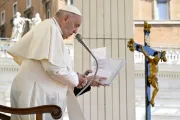2) Don't rush
We can learn a lesson about prayer by observing people in love. During a romantic candlelit dinner, no one would be constantly looking at the clock, or choking down their food, or leaving the dessert to one side to finish as quickly as possible. Rather, a romantic meal is stretched out, maybe lingering for an hour to sip a cocktail, and enjoying every moment spent together. So it is with praying the Rosary. It shouldn't be treated as sets of Hail Mary's to be performed as if one were lifting weights. I can spend time lingering on a thought. I can also break away from it. I can, principally at the beginning, simply be peaceful. If I keep this peaceful attitude and an awareness of how important this 20-minute "appointment" is, then I will have prayed well. It will have been a good prayer, because my will is focused on pleasing the Beloved and not myself.
3) Savor the experience
Saint Ignatius recommends what's called the "third form of prayer," which consists in adjusting the words to the rhythm of one's own breathing. Often it is sufficient in praying the Rosary to briefly pause between the mysteries, and to remember that Jesus and Mary are looking at me full of joy and love, recognizing with gratitude that I am like a little child babbling words every so often to in some way affirm that I love God. To do this, it can be useful to pause and take a few breaths before resuming vocal prayer.
4) A gaze of love
The vocal prayers of the Rosary only provide the rhythm of the prayer. With my thoughts, I can and should go out from the rhythm to encounter the Mystery which is being contemplated. This is more clear in German, where the mystery is announced not only at the beginning of each decade, but before each Hail Mary. It's a time to look your Beloved in the eyes and let Him look back, with eyes full of love.
5) Allow yourself to be amazed
One of the first and most important steps for inner prayer is to go from thinking and speculation to looking upon and being amazed. Think of lovers who meet, not to plan out what they're going to give each other or what they might do on the next vacation, but to enjoy the time together and to rejoice in each other. Looking at a family photo album is very different from looking at a history book. In the photo album, we see people who are important to us, whom we love – and even more – who love us! That's how our gaze at Jesus and Mary ought to be in the Rosary.
6) Allow your "inner cameraman" to notice details
Some people close their eyes while praying in order to concentrate. Others find it useful to focus their eyes on a certain point (such as a crucifix). Either way, what is important is for the eyes of the heart to be open. Praying the Rosary is like going to the movies. It's about seeing images. It's useful to ask yourself: Who, What, Where am I looking at when I contemplate the birth of Jesus, or his crucifixion, or his ascension into Heaven? And on some occasions, like a good cameraman does, come in for a close-up image of some detail: contemplate the warm breath of the ox that's warming the Child, the pierced hand of Jesus that spread so much love, the tears in John's eyes as he gazes at Jesus rising up to Heaven.
7) Pray in words, mind, and heart
(Story continues below)
Subscribe to our daily newsletter
The words accompany, the mind opens, but it is the heart that has the leading role in prayer. All the great spiritual authors agree that inner prayer is about dwelling in the affections, that is, the inner sentiments and movements. Teresa of Avila says very simply: "Don't think a lot, love a lot!" An elderly lady was ruefully complaining to me that she could not reflect while praying her daily Rosary, and that in that situation she could barely say "Jesus, Mary, I love you!" I congratulated the lady. That is exactly what praying the Rosary ought to lead us to.
This commentary was first published April 26, 2017.
The Catholic News Agency (CNA) Staff are a team of journalists dedicated to reporting news concerning the Catholic Church around the world. Our bureaus are located in Denver, Washington, and Rome. We have sister language agencies in Kenya, Germany, Peru, Brazil, and Italy. CNA is a service of EWTN News. You can contact us at news@catholicna.com with questions.




